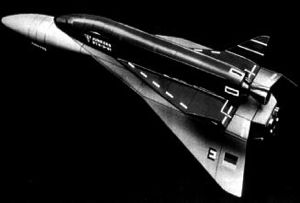
Home - Search - Browse - Alphabetic Index: 0- 1- 2- 3- 4- 5- 6- 7- 8- 9
A- B- C- D- E- F- G- H- I- J- K- L- M- N- O- P- Q- R- S- T- U- V- W- X- Y- Z
Saenger I
 Saenger 1 Spaceplane Credit: Mark Lindroos |
Status: Study 1969. Payload: 500 kg (1,100 lb). Height: 31.00 m (101.00 ft). Diameter: 3.35 m (10.99 ft). Span: 31.00 m (101.00 ft). Apogee: 300 km (180 mi).
After World War II, Saenger continued in rocket research. He worked for the French for a time - and had French intelligence to thank for thwarting a plan of Stalin's to have him kidnapped and taken to the USSR. He returned to Germany in the fifties. Renewed German work on spaceplane design began at Messerschmidt-Boelkow-Bloehm (MBB) in 1962, as a result of a vigorous campaign by Saenger to have German industry finally realize his thirty-year old dream of manned winged spaceflight. Saenger died in 1964, but MBB continued it studies in the period 1962-1969, expending DM 16.5 million in the process. The first cut, in 1963, was the last spacecraft personally designed by Saenger. This RT-8-01 concept used a sled for initial acceleration, followed by two stages to orbit, both of them of similar delta wing design.
RT-8 stood for "Raumtransporter-8", or "Space Transport 8". RT-1 to RT-7 never really existed as completed designs. They represented a range of alternative lifting-body and winged configurations, of which only a photograph of the air-dropped models remain.
The RT-8 sled was powered by a steam rocket, which propelled the first and second stages on a 3-km track to a release velocity of 900 kph. An alternative launch method would use a heavily-modified B-52 bomber for a subsonic air release. Both the first and second stages were equipped with Lox/LH2 engines, each with a sea-level thrust of 50 metric tons and a specific impulse of 430 seconds. The first stage would take the second to a 60 km altitude at 150 seconds after lift-off before releasing it and then gliding back to base. The second stage would continue on to a 300 km altitude orbit. The first stage had a shoulder-mounted delta wing with drooped wingtips giving it the compression lift characteristics of the XB-70 bomber. The upper stage was a reversed version of the first, with the low-mounted seventy-degree double-delta wing having upturned tips like that of the X-20 Dynasoar.
By 18 October 1965, following Saenger's death, the MBB study team had dropped the acceleration sled he favored and gone to a more conventional RT-8-02 two-stage to orbit vertical-takeoff concept. The figures given at the Deutsche Museum differ a little from those above, and are presented in the stage details.
LEO Payload: 500 kg (1,100 lb) to a 300 km orbit at 52.00 degrees. Crew Size: 2.
Family: European Rocketplanes, orbital launch vehicle, Spaceplane, Winged. People: Saenger. Country: Germany. Launch Vehicles: Saenger I. Bibliography: 44.
Back to top of page
Home - Search - Browse - Alphabetic Index: 0- 1- 2- 3- 4- 5- 6- 7- 8- 9
A- B- C- D- E- F- G- H- I- J- K- L- M- N- O- P- Q- R- S- T- U- V- W- X- Y- Z
© 1997-2019 Mark Wade - Contact
© / Conditions for Use